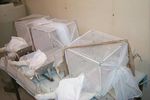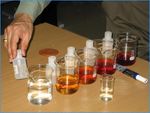Journal of Marine Science Research and Oceanography
←
→
Page content transcription
If your browser does not render page correctly, please read the page content below
ISSN: 2642-9020
Review Article Journal of Marine Science Research and Oceanography
Protocol of Mosquito Rearing for Evaluation of Different Aspects of Mosquito-
Borne Diseases
Hassan Vatandoost
Department of Medical Entomology and Vector Control School of Corresponding author
*
Public Health and Chemical Pollutants and Pesticides Institute for Hassan Vatandoost, Department of Medical Entomology and Vector Control
Environmental Research, Tehran University of Medical Sciences, School of Public Health and Chemical Pollutants and Pesticides Institute for
Tehran, Iran Environmental Research, Tehran University of Medical Sciences, Tehran,
Iran
Submitted: 26 March 2021; Accepted: 10 March 2021; Published: 06 Apr 2021
Citation: Hassan Vatandoost (2021) Protocol of Mosquito Rearing for Evaluation of Different Aspects Of Mosquito-Borne Diseases.
J Mari Scie Res Ocean, 4(1): 181-187.
Classification of Mosquitoes
They belong to the Order: Diptera, Sub-order: Nematocera, Fami-
ly: Culicidae, Genus: Anopheles, Aedes and Culex. (Fig.1). Around
3556 species of mosquitoes have been identified worldwide.
Figure 1: Larvae of Mosquito
Breeding Site of Mosquitoes Are
small pools, fresh water, rice-land, drains, ditches, running wa- Figure 3: Breeding Places of Mosquitoes
ter with shade, brackish water, salt water, stream, ponds, lakes,
marshes, well, water container, discarded tin can, discarded tyre, Mosquito vectors can transmit several pathogens, including arbo-
hoof-print. (Fig.2) viruses, protozoans and filariae that cause infectious diseases of
significant public health concern [1]. To a lesser extent, they may
also transmit bacterial diseases [2]. Mosquitoes of medical impor-
tance belong to the family Culicidae and are widely distributed
around the world. This large family currently encompasses 3556
valid species of mosquitoes distributed within the subfamilies Cu-
licinae and Anophelinae [3,4]. The mosquito vectors mainly be-
long to three genera, Anopheles, Aedes and Culex.
Diseases transmitted by mosquitoes include malaria, dengue, West
Nile virus, chikungunya, yellow fever, filariasis, tularemia, diro-
filariasis, Japanese encephalitis, Saint Louis encephalitis, West-
ern equine encephalitis, Eastern equine encephalitis, Venezuelan
equine encephalitis, Ross River fever, Barmah Forest fever, La
Crosse encephalitis, and Zika fever, as well as newly detected
Keystone virus and Rift Valley fever [5, 6]. Nearly 700 million
people get a mosquito-borne illness each year resulting in over one
million deaths.
J Mari Scie Res Ocean, 2021 www.opastonline.com Volume 4 | Issue 1 | 181human bait, larval collection, light trap.
Outdoor collection of mosquitoes are: on vegetable, on solid sur-
faces in shelter places, bank of stream, bank of ditches, hole in
rocks, culverts, cracks, caves, animal burrows, on the trunk of
trees, termite mounds.
Outdoor collection of mosquitoes are; collecting mosquito out-
doors with a sucking tube, hand net, drop net, artificial outdoor
shelters. Direct collection of mosquitoes from bait are; human bait
indoors, human bait outdoors, animal bait outdoors, human-baited
trap net, animal baited trap net.
Figure 4: Global Distribution of Anopheles Species
Figure 5: The Global Distribution of the Arbovirus Vectors Aedes
aegypti
Figure 6: The Global Distribution of the Arbovirus Vectors Ae.
Albopictus
Figure 8: Different Methods of Collection of Mosquitoes
Establishment of Insectary for Rearing Of Mosquitoes
An important factor for carrying out all the laboratory works are
rearing and maintain the mosquito under insectary conditions.
Equipment for Handling Mosquito Adults
Figure 7: Global Distribution of Culex Species Cages
A wide variety of rearing cages, Size is related to the numbers
Different Method for Mosquito Collection are: of mosquitoes to be caged. This density affects mating, feeding
Indoor hand catch, outdoor hand catch (shelter pits), animal bait, and longevity. A vertical resting surface of 1.8 cm2 per mosquito,
J Mari Scie Res Ocean, 2021 www.opastonline.com Volume 4 | Issue 1 | 182Many species will not mate in cages less than 30 x 30 x 30 cm.Ae- Sources of Blood
des, Culex, and Anopheles , Freshly colonized from the field will Include guinea pigs, mice, rats, chicken and Rooster, rabbit,
only mate successfully in cages of 1 x 1X 1 m or more, Toxo- (Fig.12)
rhynchites and sometime some Anopheles species
Cage Frame
wood, metal, brass, aluminum. The front of the cage should have a
fabric sleeve wide enough to allow the introduction of small bowls
(12 cm diameter) for egg laying. A solid base is preferable to one
of netting as it has to support bowls containing pupae or water for
egg laying (Fig.9)
Figure 12: Sources Of Adult Food Of Mosquitoes
Figure 9: Cages for Mosquito Collection Under Insectary Condi-
tions Adult Food Mammals are usually shaved with hair clippers on the flank prior
to feeding (Fig.13. Fig.14)
Water for adults may be provided in small bowls or in the form
of water socked cotton wool pads placed on top of the cage. 10%
solutions sucrose in a cotton wool. Sliced apples of raisins or sul-
tanas on the cage tops.
Blood Meals
Blood meals are necessary for egg production in all but the few
autogenous species. Colonies are usually fed blood twice a week.
One of the simplest methods involves placing an anesthetized ani-
mal on the cage (Fig.10. Fig.11).
Figure 13: Shaved Mammals for Blood Feeding
Figure 10: Blood Feeding of Mosquitoes On Guinea Pig
Figure 14: Blood Feeding of Mosquitoes On Rabbit
Artificial Feeding
Membrane feeding system, this technique is more usually reserved
for infecting mosquitoes with malaria, filarial or arboviruses
(Fig.15)
Figure 11: Blood Feeding of Mosquito
J Mari Scie Res Ocean, 2021 www.opastonline.com Volume 4 | Issue 1 | 183Figure 15: Apparatus for Artificial Feeding of Mosquitoes
Figure 18: Mouth Aspirator with Filter
For field use the smaller numbers of mosquitoes are often housed
in cylinders of plastic or cardboard ice-cream cartons with netting Egg collection
end (Fig.16) The eggs of Anopheles are not drought resistance and are laid in-
dividually on the surface of free water, usually fresh, in a bowl.
Sometimes filter paper is placed inside the bowl to prevent eggs
sticking to the sides or to facilitate transfer of eggs. The eggs can
sometimes be transported on damp filter paper although at room
temperature they will hatch within a couple of days .Chilling may
sometimes be used to delay hatching.
Larval Rearing Procedures
Trays roughly 30 x 25 x 5 cm are suitable for holding water to
depth of around 4 cm with 300 larvae per tray (Fig.19).
Figure 16: Cylinders of Plastic or Cardboard Ice-Cream
Adult mosquitoes are transferred between cages by means of an
aspirator or suction device (Fig.17, Fig.18)
Figure 19: Trays for Larval Collection
Larvae are handled and transferred using glass pipettes, plastic pi-
pettes or eye dropper (Fig.20)
Figure 20: Transferring Larvae by Glass Pipettes, Plastic Pipettes
or Eye Dropper
Larval Food
An extraordinary variety of materials have been used a larval
food, ranging from guinea pig faces to well defined chemical diets.
Commercial dog biscuit, yeast tablets, liver powder, dried blood,
fish food flakes, baby food also are being used (Fig.21).
Figure 17: Aspirator or Suction Device
J Mari Scie Res Ocean, 2021 www.opastonline.com Volume 4 | Issue 1 | 184Figure 24: Maximum and Minimum- Thermometer
Figure 21: Larval Food of Mosquito Humidity Control
provided by small commercially available mist/aerosol producing
Handling of pupae devices (Fig.25).
Pupae may be picked with tent ended glass pipettes of the type
used to handle larvae or with small netting lifters (Fig.22).
Figure 25: Equipment for Humidity Control of Insectary
Photoperiod Control
Some species may require a crepuscular period to swarm and mate.
Figure 22: Collection of Pupae Insectary Design This may necessitate insectary controls for automatic dimming of
lights to provide a dust effect and gradual increase in brightness to
The three main requirements for an insectary are an ability to con- simulate dawn dimming of lights (Fig.26)
trol temperature, humidity, and photoperiod (Fig.23)
Figure 23: Rows of Insectary Figure 26: Down and Dusk Control in The Insectary
Temperature Control Safety Correct Rearing Procedures
Regular temperature records should be taken in the insectary. A white painted walls, a white painted ante-room, drains may re-
maximum-minimum thermometer and/or recording thermo hygro- quire, screening, oviposition traps Insectary should not be sited in
graph for this purpose. Temperature range 26-28 °C. Maximum close proximity to animal rooms.
and minimum- thermometer is required (Fig. 24)
J Mari Scie Res Ocean, 2021 www.opastonline.com Volume 4 | Issue 1 | 185Using of Mosquito Reared for Evaluation of Insecticide
There are several guidelines for evaluation of susceptibility of
mosquito to WHO recommended insecticide at the adult and larval
stage as weel as evaluation of bednet [7, 16]. (Figs 27,28,29,30,31)
Figure 31: Adult Susceptibility Test
References
1. Becker N, Petric D, Zgomba M, Boase C, Dahl C, et al.
(2010) Mosquitoes and their control. 2nd Edition. Heidelberg:
Springer.
2. Dieme C, Bechah Y, Socolovschi C, Audoly G, Berenger JM,
et al. (2015) Transmission potential of Rickettsia felis infec-
tion by Anopheles gambiae mosquitoes. Proc Natl Acad Sci
Figure 27: Conical Bioassay Test 112: 8088-8093.
3. Harbach RE (2013) Mosquito taxonomic inventory. http://
mosquito-taxonomic-inventory info/. Accessed 15 May 2018.
4. Carnevale P, Robert V, Manguin S, Corbel V, Fontenille D, et
al. (2009) Les anophèles - biologie, transmission du Plasmo-
dium et lutte antivectorielle. IRD ed: Marseille, 1-391.
5. Caraballo Hector, Kevin King (2014) Emergency Department
Management of Mosquito-Borne Illness: Malaria, Dengue,
And West Nile Virus. Emergency Medicine Practice 16: 1-23.
6. Diseases that can be Transmitted by Mosquitoes - Minnesota
Figure 28: Tunnel Test Dept. of Health. www.health.state.mn.us. Retrieved 2018-02
15.
7. World Health Organization (WHO) (2015) Global technical
strategy for malaria 2016-2030. WHO 2015: 1-32.
8. World Health Organization (WHO) (2013) Malaria entomol-
ogy and vector control. Participants guide. WHO 2013:1-190.
9. Hougard JM, Duchon S, Darriet F, Zaim M, Rogier C, et al.
(2003) Comparative performances, under laboratory condi-
tions of seven pyrethroid insecticides used for impregnation
of mosquito nets. Bull World Health Organ. 81: 324-333.
10. World Health Organization (WHO) (1970) Insecticide re-
sistance and vector control. Seventeenth report of the WHO
Expert Committee on Insecticides. World Health Organ Tech
Figure 29: Larval Susceptibility Test Rep Ser 443:1-279.
11. Gefter IM (1963) Insecticide resistance and vector control.
Thirteenth report of the Expert Committee on Insecticides.
World Health Organ Tech Rep Ser 265:1-227.
12. Macdonald WW (1972) Vector control and the recrudescence
of vector borne disease. World Health Organization.
13. WHO (1964) Insecticides resistance andvectorcontrol. 10th
report of the WHO Expert Committee on insecticides. Vector
resistance to pyrethoids. WHO Tech Rep Ser 1964: 1-191.
14. WHO (1970) Insecticides resistance and vector control. 17th
report of the WHO Expert Committee on insecticides. Instruc-
tions for determining the irritability of adult mosquitoes to in-
secticides. WHO Tech Rep Ser 433: 158-163.
Figure 30: Irritability Tests 15. Hougard J M, Duchon S, Darriet F, Zaim M, Rogier C, et al.
(2003) Comparative performances, under laboratory condi-
tions, of seven pyrethroid insecticides used for impregnation
of mosquito nets. Bull World Health Organization 81: 324-
J Mari Scie Res Ocean, 2021 www.opastonline.com Volume 4 | Issue 1 | 186333.
16. Coluzzi, Mario & World Health Organization (1962) An ex-
perimental method for determining the irritability of adult
mosquitos to insecticides / by M. Coluzzi. World Health Or-
ganization.
Copyright: ©2021 Hassan Vatandoost. This is an open-access article
distributed under the terms of the Creative Commons Attribution License,
which permits unrestricted use, distribution, and reproduction in any
medium, provided the original author and source are credited.
J Mari Scie Res Ocean, 2021 www.opastonline.com Volume 4 | Issue 1 | 187You can also read



























































